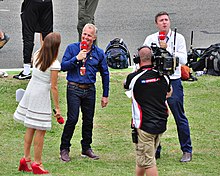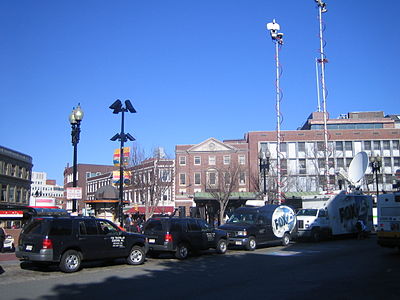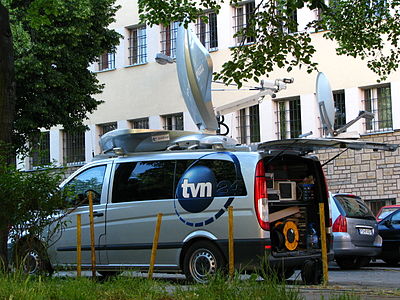| This article needs additional citations for verification. Please help improve this article by adding citations to reliable sources. Unsourced material may be challenged and removed. Find sources: "Outside broadcasting" – news · newspapers · books · scholar · JSTOR (June 2018) (Learn how and when to remove this message) |

Outside broadcasting (OB) is the electronic field production (EFP) of television or radio programmes (typically to cover television news and sports television events) from a mobile remote broadcast television studio. Professional video camera and microphone signals come into the production truck for processing, recording and possibly transmission.
Some outside broadcasts use a mobile production control room (PCR) inside a production truck.
History
| This section needs expansion with: additional information on early broadcasts, and history beyond 1953. You can help by adding to it. (November 2019) |

Outside radio broadcasts have been taking place since the early 1920s and television ones since the late 1920s. The first outside broadcast by the British Broadcasting Company was of the British National Opera Company production of The Magic Flute from the Royal Opera House, Covent Garden on 8 January, 1923. The first large-scale outside broadcast was the televising of the Coronation of George VI and Elizabeth in May 1937, done by the BBC's first Outside Broadcast truck, MCR 1 (short for Mobile Control Room).
After the Second World War, the first notable outside broadcast was of the 1948 Summer Olympics. The Coronation of Elizabeth II followed in 1953, with 21 cameras being used to cover the event.

In December 1963 instant replays were used for the first time. Director Tony Verna used the technique on the Army-Navy game which aired on CBS Sports on December 7, 1963.
The 1968 Summer Olympics was the first with competitions televised in colour. The 1972 Olympic Games were the first where all competitions were captured by outside broadcast cameras.
During the 1970s, ITV franchise holder Southern Television was unique in having an outside broadcast boat, named Southener.
The wedding of Prince Charles and Lady Diana Spencer in July 1981 was the biggest outside broadcast at the time, with an estimated 750 million viewers.
New technology
In 2008, the first 3D outside broadcast took place with the transmission of a Calcutta Cup rugby match, but only to an audience of industry professionals who had been invited by BBC Sport.
In March 2010, the first public 3D outside broadcast took place with an NHL game between the New York Rangers and New York Islanders.
The first commercial ultra-high definition outside broadcast was a Premier League game between Stoke City v West Ham, televised by Sky Sports in August 2013.
Tests in 8K resolution outside broadcasts began to take place during the 2010s, including tests by NHK and BT Sport. The first public 8K outside broadcast in the UK took place in February 2020.
Modern applications
Main article: Production truckModern outside broadcasts now use specially designed OB vehicles, many of which are now built based around IP technology rather than relying on coaxial cable.
There has been an increasing rise in the use of flyaway or flypack Portable Production Units, which allow for an increased level of customisation and can be rigged in a larger variety of venues.
In the past many outside broadcasting applications have relied on using satellite uplinks to broadcast live audio and video back to the studio. While this has its advantages such as the ability to set up anywhere covered by the respective geostationary satellite, satellite uplinking is relatively expensive and the round trip latency is in the range of 240 to 280 milliseconds.
As more venues install fiber optic cable, this is increasingly used. For news gathering, contribution over public internet is also now used. Modern applications such as hardware and software IP codecs have allowed the use of public 3G/4G networks to broadcast video and audio. The latency of 3G is around 100–500 ms, while 4G is less than 100 ms.
Gallery
-
 Outside broadcast vehicles at Raymond James Stadium in advance of Super Bowl LV
Outside broadcast vehicles at Raymond James Stadium in advance of Super Bowl LV
-
An ABS-CBN OB van transmitting a satellite feed
-
 WFXT's trucks in Boston's Harvard Square
WFXT's trucks in Boston's Harvard Square
-
 Camera operator working on an outside broadcast of a football match at Wembley Stadium
Camera operator working on an outside broadcast of a football match at Wembley Stadium
-
 A BBC Radio outside broadcasting van at New College, Oxford
A BBC Radio outside broadcasting van at New College, Oxford
-
 An Ikegami camera with Canon DIGISUPER lens of ORF at a football match
An Ikegami camera with Canon DIGISUPER lens of ORF at a football match
-
 A TVN24 outside broadcasting van in Poznań, Poland
A TVN24 outside broadcasting van in Poznań, Poland
-
OB for tennis tournament: Extendible-sided production van, satellite dishes, generator truck; see two OB cameras and three announcing booths at top of stadium beyond. Kooyong, Victoria, Australia, 2008
-
 Klotz Digital's Vadis DC II mixer for use at a Virgin Radio outside broadcast at the V Festival 2007
Klotz Digital's Vadis DC II mixer for use at a Virgin Radio outside broadcast at the V Festival 2007
See also
References
- Seatter, Robert (25 March 2016). "The cello and the nightingale". BBC News Online. Retrieved 30 March 2020.
- "How the BBC took the news outside". BBC News - In Pictures. BBC News. 10 March 2016. Retrieved 16 November 2019.
- Asa Briggs. The Birth of Broadcasting, OUP (1961), p. 275
- "Coronation of King George VI and Queen Elizabeth, 12 May 1937". History of the BBC. BBC. 3 June 2014. Retrieved 16 November 2019.
- "TV OUTSIDE BROADCAST HISTORY". TV Outside Broadcast History. Retrieved 2018-05-28.
- Webb, Dr Alban. "1948 London Olympics". History of the BBC. BBC. Retrieved 16 November 2019.
- "The Coronation and The BBC". About the BBC Blog. BBC. 28 May 2013. Retrieved 16 November 2019.
- "Television reigns: Broadcasting Queen Elizabeth's coronation". Science Museum. Retrieved 16 November 2019.
- "He Invented Instant Replay, The TV Trick We Now Take For Granted", Morning Edition, NPR, January 20, 2015
- "First summer Olympic Games televised in colour". Guinness World Records. Retrieved 26 May 2020.
- "The amazing story of broadcasting the Olympic Games". www.olympic.org. Retrieved 26 May 2020.
- Dormer, Ian (15 April 2017). "Outside broadcast: Then and now". Screen Africa. Retrieved 26 May 2020.
- Marshall, Paul (19 May 2019). "Southerner". Broadcast Engineering Conservation Group. Retrieved 26 May 2020.
- "1981: Charles and Diana marry". On This Day. BBC News. 29 July 1982. Retrieved 13 October 2008.
- "Christie HD8K's collaborate with The 3D Firm in groundbreaking stereoscopic event at the Riverside Studios". Live Production. 8 March 2008. Retrieved 26 May 2020.
- "Grass Valley Kalypso HD Switcher Handles First Ever 3D Sports Broadcast to the Home | LIVE-PRODUCTION.TV". Live Production. 5 April 2010. Retrieved 26 May 2020.
- Warman, Matt (31 August 2013). "Sky in ultra high-definition TV first". Retrieved 26 May 2020.
- Davies, David (3 July 2015). "Live from Wimbledon 2015: NHK undertakes latest 8K trial". SVG Europe. Retrieved 26 May 2020.
- "BT Sport Chooses Ikegami's SHK-810 Camera for 8K Demo at IBC 2019". Sports Video Group. 27 September 2019. Retrieved 26 May 2020.
- Bickerton, Jake (28 February 2020). "BT Sport shows UK's first public live 8K HDR sports broadcast". Broadcast Sport. Retrieved 26 May 2020.
- Mann, Colin (28 February 2020). "BT claims UK 8K sports broadcast first". advanced-television.com. Retrieved 26 May 2020.
- Bickerton, Jake (19 June 2018). "Arena reveals OBZ, its fourth UHD-HDR IP truck". Broadcast. Retrieved 24 June 2019.
- Dams, Tim (19 June 2018). "Trickbox TV unveils 12-camera 4K flypack". Broadcast. Retrieved 24 June 2019.
- "Geostationary satellite latency and time delay 240ms - 279ms". www.satsig.net.
- "SIS LIVE expands Anylive network". TVBEurope. 11 September 2016. Retrieved 24 June 2019.
- "O'Reilly Media - Technology and Business Training". www.oreilly.com.
External links
- Recreation of a full 1970s BBC Outside Broadcast production
- Technical planning stage of a 1970s Outside Broadcast production
- Demonstration of the 'lining up' process for EMI 2001 OB camera from the 1970s
- Discussion and demonstration of the microphone and communications set up for a sports OB
- BBC Outside Broadcast crew reflect on their careers in OB production
- TV Outside Broadcast History Website
| Broadcasting | |
|---|---|
| Medium | |
| Broadcasting niche | |
| Specialty channels | |
| Production and funding | |